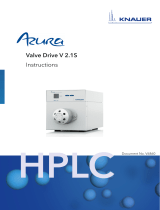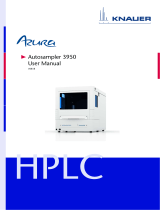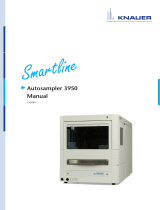Page is loading ...

1.0 DESCRIPTION
Loop Filler Ports (Models 7012, 9012)
and Needle Port (Model 9013) are
accessories for sample injection valves.
The ports use conventional syringes to
load the sample loop. Needle Ports are
designed for minimal sample waste and
are used when there is access to the
stator end of the sample injector. PEEK
Models 9012 and 9013, can be used
in analyses requiring
biocompatibility, with no metal contact in
the fluid stream.
Figure 1 shows an exploded view of
Models 7012 and 9012. The PTFE liner
tube of the needle port fitting in Models
7012 and 9012 butts against the end of
the connecting tube. Models 7012 and
9012 accommodate #22 gauge [0.7 mm
(0.028") OD] syringe needles, but the
fittings can tighten to accommodate #26
gauge [0.5 mm (0.018") OD] syringe
needles.
Models 7012 and 9012 require square
cut needles (90° point style), with or
without electrotaper, that are at least 31.3
mm (1.25") long. The open end of the
needle port fitting can be attached to the
luer tip of syringes without a needle (luer-
slip or luer-lok). The needle port fitting on
Models 7012 and 9012 also accept the tip
of a Needle Port Cleaner (P/N 7125-054).
Model 9013 consists of three parts: 33 mm,
10-32, 1/16" RheFlex® PEEK nut and
ferrule set and PTFE liner tube.
Model 9013 accommodates #22 gauge
[0.7 mm (0.028") OD] syringe needles, but
the adjustable seal can accommodate
#26 gauge [0.5 mm (0.018") OD]
syringe needles.
Models 9013 requires square cut
needles (90° point style) that are at
least 43.8 mm (1.75") long.
2.0 SUPPLIED WITH LOOP FILLER
PORTS
2.1 Model 7012
•RheFlex Stainless Steel Fittings set
•0.3 mm (0.012") ID Connecting Tube
•Needle Port Cleaner
2.2 Model 9012
•RheFlex PEEK Fittings set
•0.3 mm (0.010") ID Connecting Tube
•0.5 mm (0.020") ID Connecting Tube
to rapidly load large sample volumes
without high flow resistance
•Needle Port Cleaner
3.0 SPECIFICATIONS
•Wetted Surfaces: Model 7012 -
stainless steel and PTFE; Model 9012
and 9013 -PEEK and PTFE
4.0 IMPORTANT SAFETY NOTICES 4.1
Warning (For Models 7012 and 9012):
The luer tip of a glass syringe breaks
easily. The supplied Needle Port Cleaner
can help prevent breaks. Push the Needle
Port Cleaner onto the syringe tip (not luer-
lok). The PTFE tip of the Needle Port
Cleaner can now be pushed into the luer
opening of the Loop Filler Port for
flushing or suction loading. 4.2 Caution:
When using a PEEK valve, use only
RheFlex PEEK fittings. Metal fittings can
cause irreparable damage to the PEEK
stator.
5.0 INSTALLATION
5.1 MODELS 7012 AND 9012
Models 7012 and 9012 can each be
mounted on a panel [4.0 mm (0.160")
maximum panel thickness] as illustrated
in Figure 2. IDEX Health & Science
offers two panels with pre-drilled holes:
Mounting Panel (P/N 7160) and Valve
Angle Bracket (P/N 7160-010).
To panel mount, refer to Figures 1 and 2,
and proceed as follows:
a) Remove the needle port fitting and
the junction (with the connecting tube
attached) from the panel bushing.
b) Insert the panel bushing through the
panel hole and tighten in place with the
spacer and the junction screwed in
fingertight on the opposite side of the
panel.
c) Attach the open end of the connecting
tube to the appropriate valve port.
d) Use the RheFlex nut and ferrule
supplied to make this connection leak-tight.
e) Reinstall the needle port fitting into
the panel bushing.
f) Adjust the tightness of the needle port
fitting to your syringe needle. Insert
your syringe needle and tighten the fittings
into the valve port until you feel an
increased resistance during the insertion
of the syringe needle. Do not
overtighten the fittings.
Note: If the loading method is suction
loading, described in Section 6.2, you
may attach the Loop Filler Port directly to
the luer tip of the suction syringe without
mounting to a panel. See Warning 4.1.
5.2 MODEL 9013
a) Screw the Needle Port into an
appropriate valve port for sample loading.
Figure 3 shows Model 9013 Needle Port
connected to an injector. Ensure the
PTFE tube is bottomed in the valve port as
shown in Figure 4.
b) Adjust the tightness of the Needle Port
to your syringe needle. Insert your syringe
needle and tighten the fittings into the
valve port until you feel an increased
resistance during the insertion of the
syringe needle. Do not overtighten the
fittings.
Operating Instructions
Model 7012, 9012 Loop Filler Port
Model 9013 Needle Port
Fig. 1. Exploded view of Loop Filler Ports.
Connecting Tube Spacer Panel Bushing
PTFE Liner Tube PTFE Ferrule
Models 7012 and 9012
Needle Port Fitting
Junction
RheFlex Ferrule
RheFlex Nut
Page 1 of 2
2320606E
08/24/2016
IDEX Health & Science • 600 Park Court, Rohnert Park, CA 94928 • (707) 588-2000 • Fax (707) 588-2020 www.idex-hs.com

6.0 OPERATION
Using an excess of sample to load
the sample loop of sample injectors
ensures that the sample loop completely
displaces the mobile phase in the sample
loop. As sample flows into the loop, the
sample/mobile phase boundary becomes
diffuse, requiring two to five sample loop
volumes before the loop contains only
undiluted sample.
Models 7012 and 9012 can use two
loading methods to load the sample loop
in excess: pressure loading and
suction loading. Suction loading is used
with PEEK valves and accessories for
analyses that must avoid metal contact.
Model 9013 is conveniently designed
for minimal sample waste during
syringe loading of the sample loop. The
only volume between the syringe needle
and the loop is contained in the injector
stator.
6.1 PRESSURE LOADING (FOR LOOP
FILLER PORTS ONLY)
To load the sample loop using
pressure loading, insert the syringe needle
into Model 7012 or 9012 and dispense
two to five sample loop volumes to
completely fill the sample loop with pure
sample. Figure 5 is a schematic diagram
of pressure loading a sample injector
with a Loop Filler Port.
6.2 SUCTION LOADING (FOR LOOP
FILLER PORTS ONLY)
Suction loading method is used when
the analysis must avoid metal contact. To
load the sample loop using suction
loading, use the syringe and Model
9012 to suck the sample from a sample
vial into the sample loop through a dip
tube attached to an appropriate valve
port (see Figure 6). Keep the dip tube
length as short as possible to minimize
sample waste.
The female luer port of Model accepts
a luer tip syringe. The syringe used in
suction loading can be used multiple
times before emptying becomes
necessary. After each injection, ensure
that the dip tube is wiped or rinsed clean.
6.3 DIRECT LOADING (FOR NEEDLE
PORTS ONLY)
Using Model 9013 to load the sample
loop, insert the syringe needle into
Model 9013 connected to a sample
injector, and dispense two to five sample
loop volumes of sample (see Figure 4).
Fig. 4. Model 9013 Needle Port bottomed in IDEX Health & Science sample injectors.
Fig. 2. Panel mounting holes for mounting Model
7012 or 9012 Loop Filler Port with a IDEX Health
& Science® sample injector.
3012
0.75
0.18 (2)
0.38
0.54 0.54
1.08
Fig. 3. Mod el 9013 connected to a
IDEX Health & Science sample injector.
Page 2 of 2
2320606E
08/24/2016
Waste
3
2
4
6
5
1
Column
Sample
Vial
Pressure
Loading
Syringe
Sample Loop
Dip Tube
3
2
4
6
5
1
Column
Suction
Loading
Sample Loop
Pump
Pump
Syringe
Fig. 6. Using a Loop Filler Port to fill the loop by suction loading. In suction loading
sample is sucked from a vial into the loop using a dip tube.
Fig. 5. Using a Loop Filler Port to fill the loop by pressure loading.
9012
7012
9013
IDEX Health & Science • 600 Park Court, Rohnert Park, CA 94928 • (707) 588-2000 • Fax (707) 588-2020 www.idex-hs.com
/






